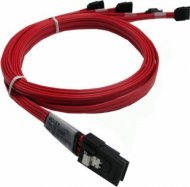Data Storage System Sas
 Last time, you and I reviewed everything with regard to SCSI technology in a historical context: who it was invented, how it evolved, what kinds it had, and so on. We have concluded that the most modern and relevant standard is Serial Attached SCSI, it has emerged relatively recently but has been developed rapidly. The first implementation of the cremony showed LSI in January 2004, and in November of the same year SAS entered the top of the most popular requests for storagesearch.com.
Last time, you and I reviewed everything with regard to SCSI technology in a historical context: who it was invented, how it evolved, what kinds it had, and so on. We have concluded that the most modern and relevant standard is Serial Attached SCSI, it has emerged relatively recently but has been developed rapidly. The first implementation of the cremony showed LSI in January 2004, and in November of the same year SAS entered the top of the most popular requests for storagesearch.com.
Let's start with the base. How does the devices work for SCSI technology? In SCSI, everything is built on the client/server concept.
The client, called the initiator, sends different teams and awaits their results. Most often, of course, the SAS counteroler is the client. Today, SAS controllers are HBA and RAID controllers, as well as CCB controllers inside external data storage systems.
 The server is called a target device (angl target), its task is to accept the request of the proponent, process it and return the data or confirm the performance of the team back. A separate disk and a whole disk may act as a target device. In this case, SAS HBA inside the disk array (so-called external data storage system) intended to connect servers to it is operated on the Target mode. A separate SCSI Target ID identifier shall be assigned to each target device (“target”).
The server is called a target device (angl target), its task is to accept the request of the proponent, process it and return the data or confirm the performance of the team back. A separate disk and a whole disk may act as a target device. In this case, SAS HBA inside the disk array (so-called external data storage system) intended to connect servers to it is operated on the Target mode. A separate SCSI Target ID identifier shall be assigned to each target device (“target”).
The data delivery subsystem is used to link clients to the server (Angl. Service Delivery Subsystem), in most cases, it's a clever name covering just cables. Cabs are both for external connections and for intra servers. Cabs change from generation to generation of SAS. There are three generations of SAS for today:
Cabs change from generation to generation of SAS. There are three generations of SAS for today:
- SAS-1 or 3Gbit SAS
- SAS-2 or 6Gbit SAS
- SAS-3 or 12 Gbit SAS - preparing for exit in mid-2013
SAS internal and external cables
Sometimes the subsystems may include SAS extensions or expansioners. Expanders (angl. Expanders, extensioners, but in Russian the word " Expander " ) understand devices that help to deliver information from the initiators to and from the target, but are transparent for the target devices. One of the most typical examples is the expansioner, which allows several target devices to be connected to one port of the initiator, such as the micro-schem of expansioner in the disk or on the backbone of the server. Through this organization, servers can have more than eight disks (controllers currently used by lead servers, usually 8-ports), and disk shelves can have any number required.













